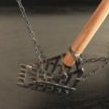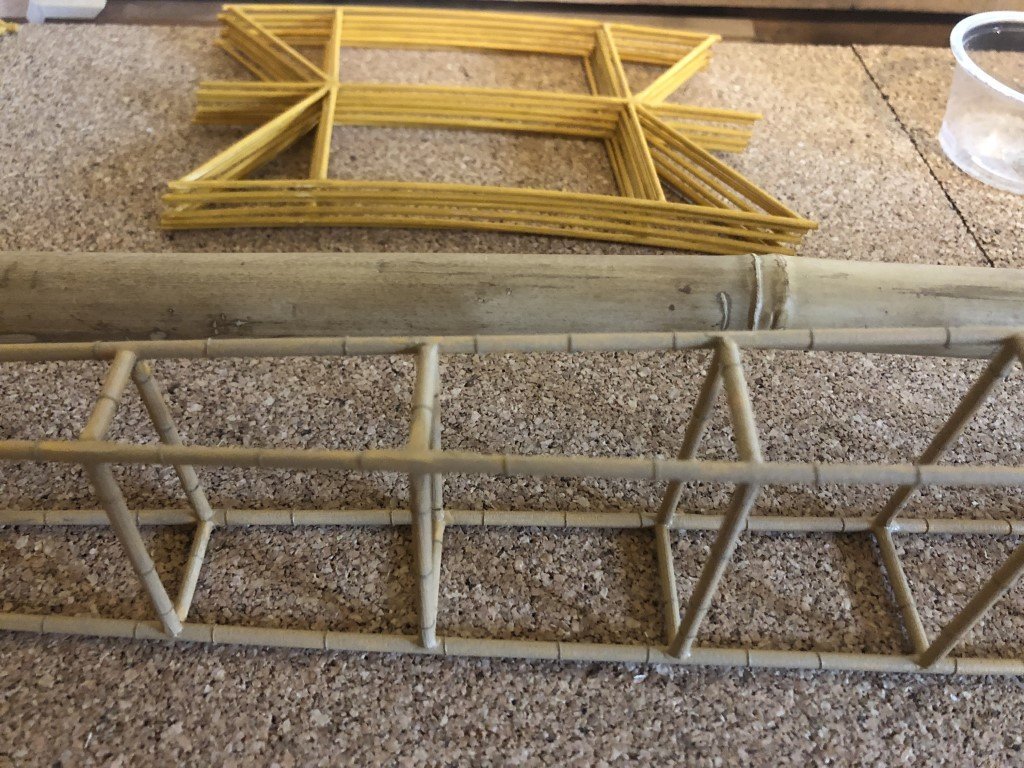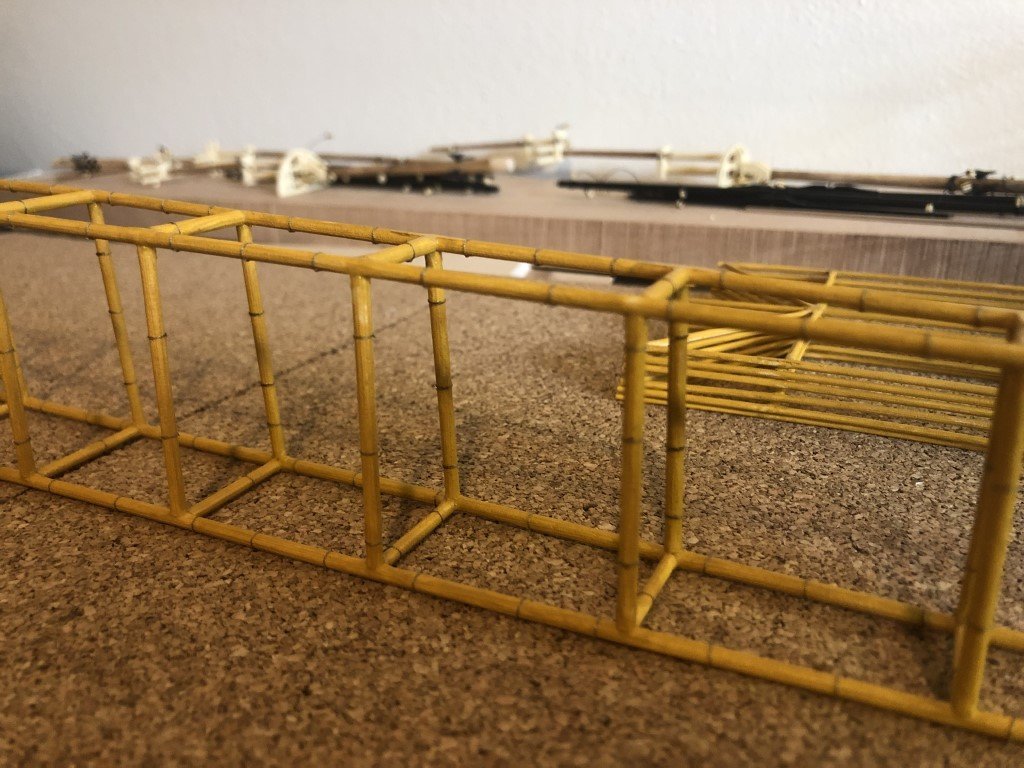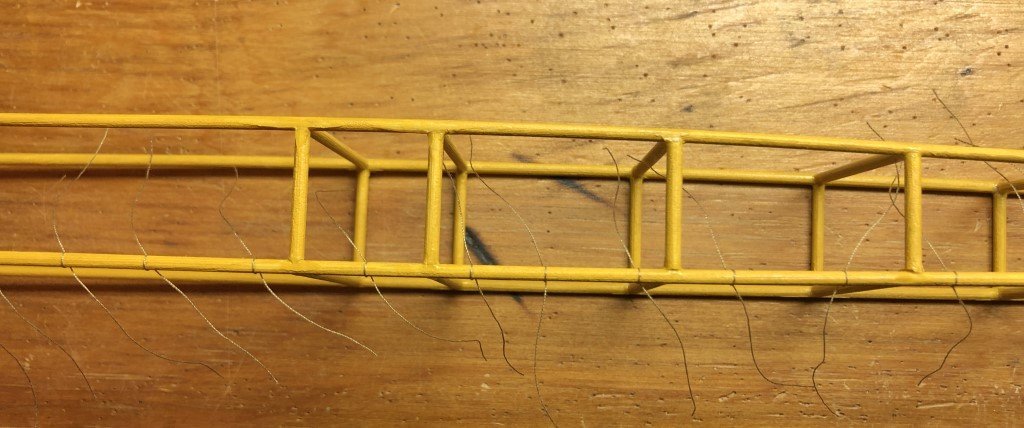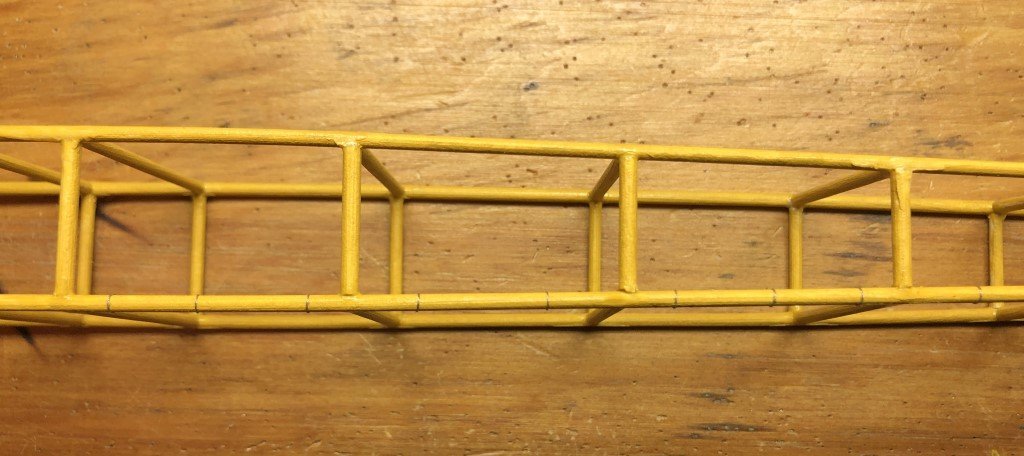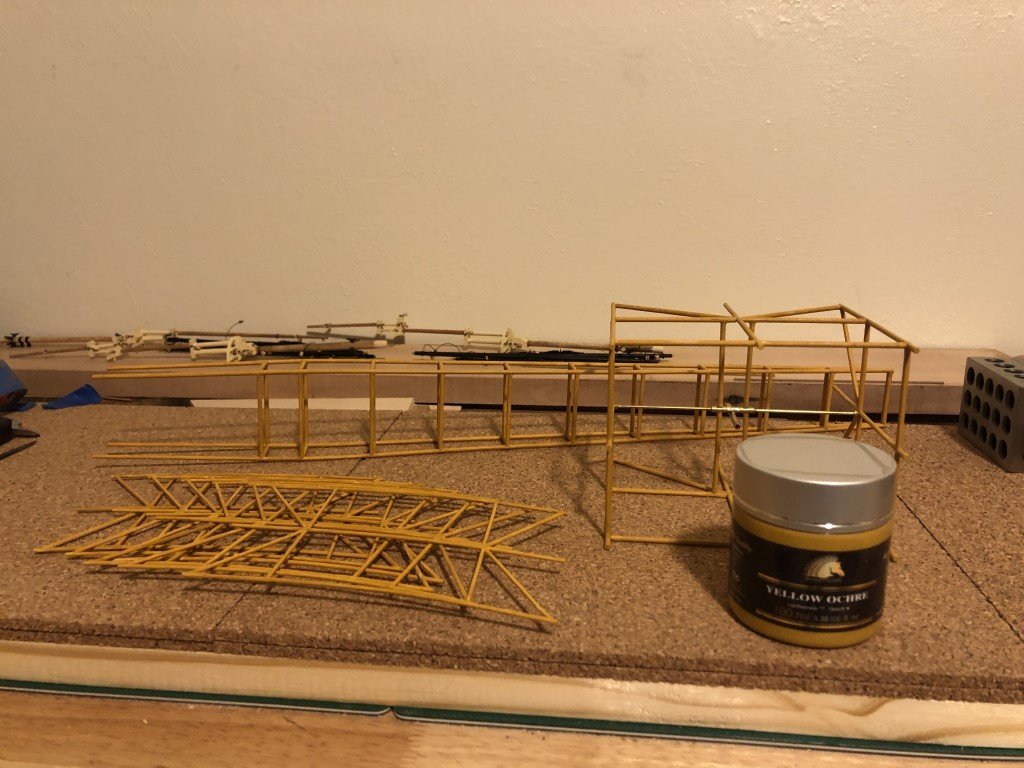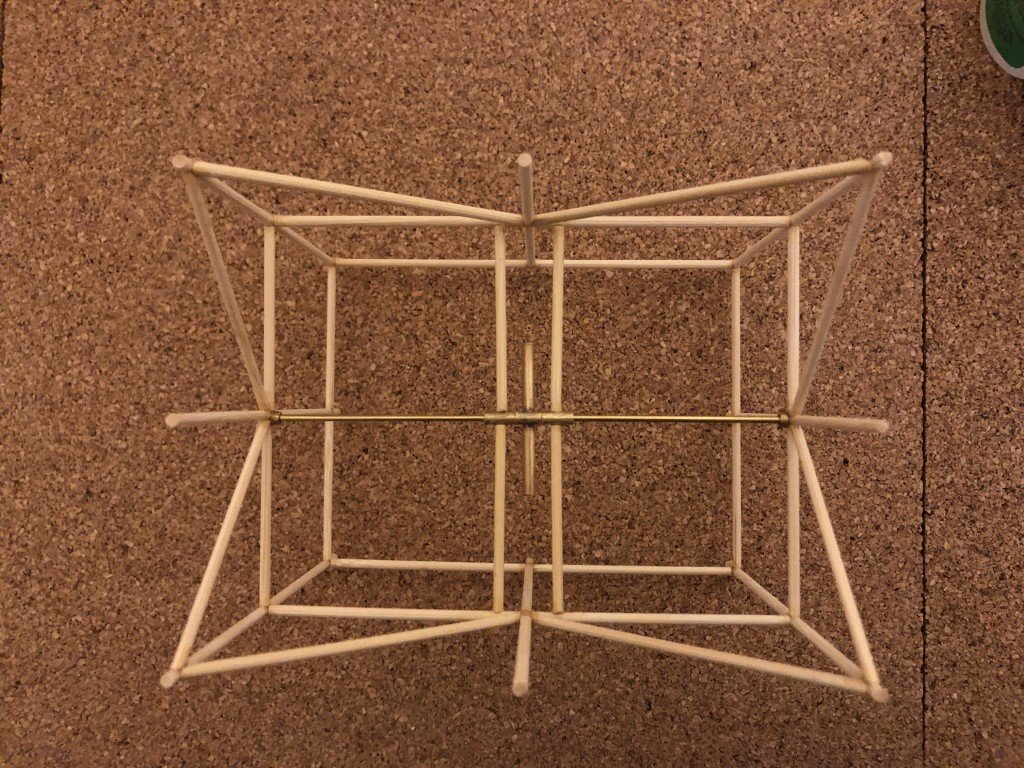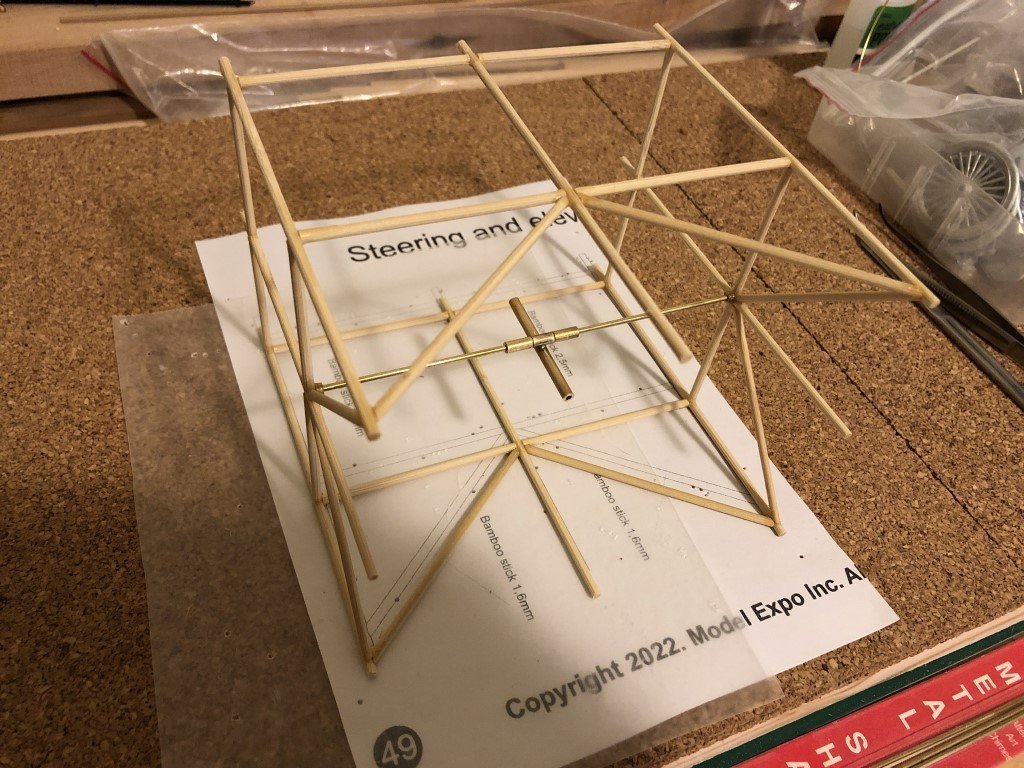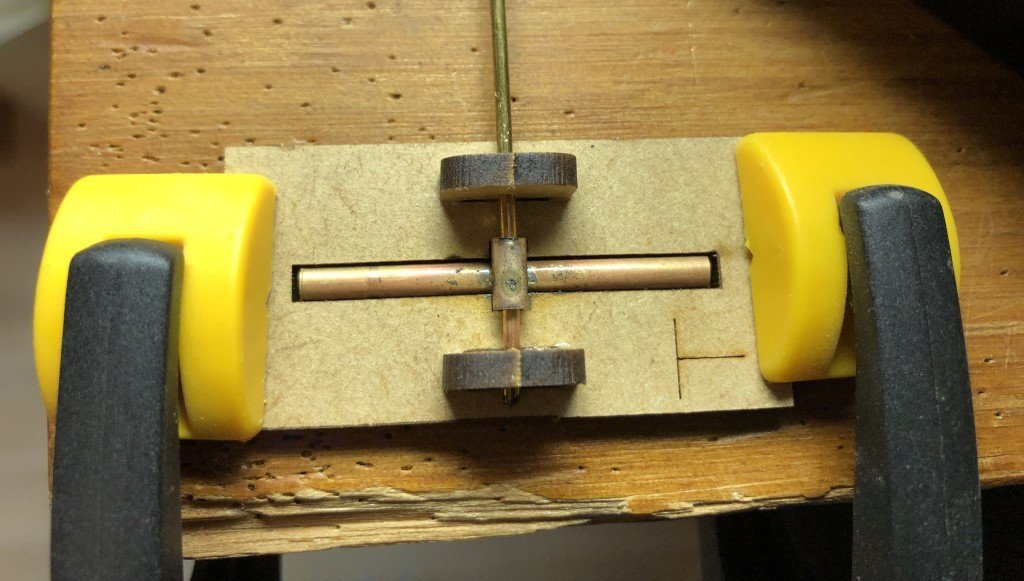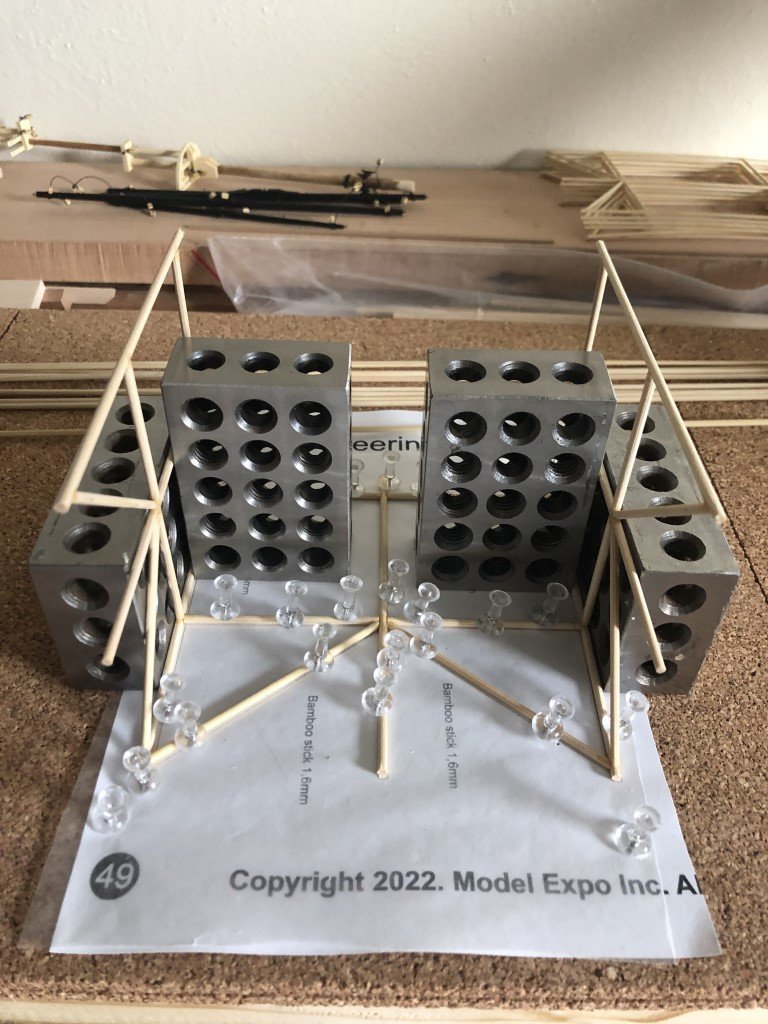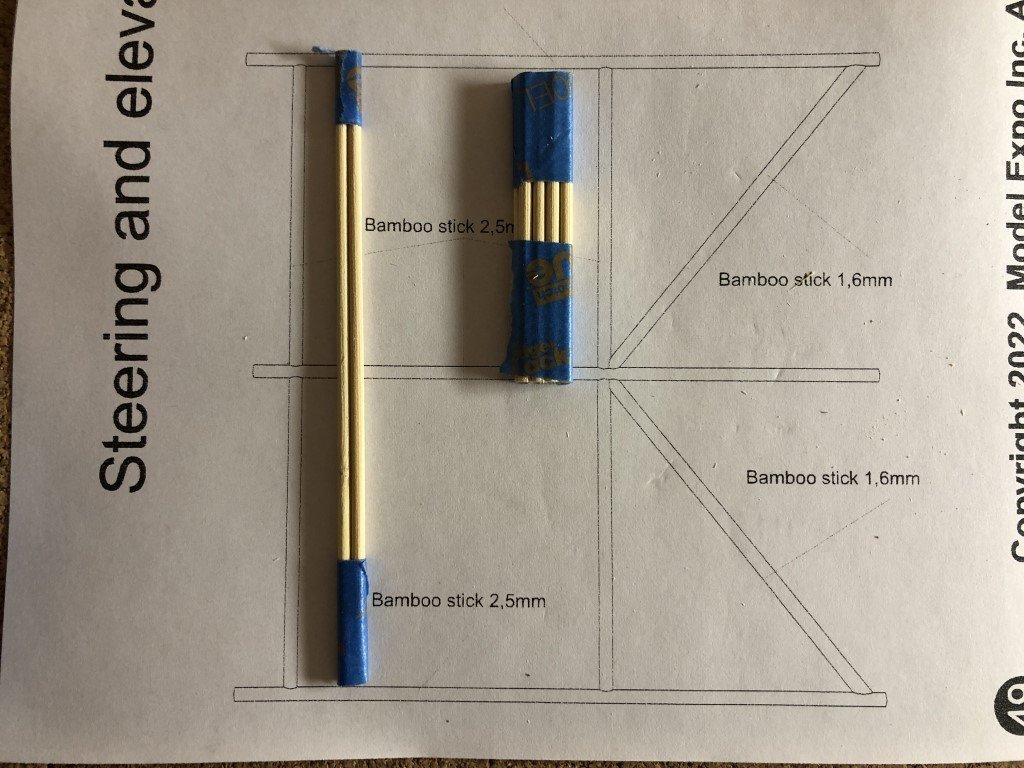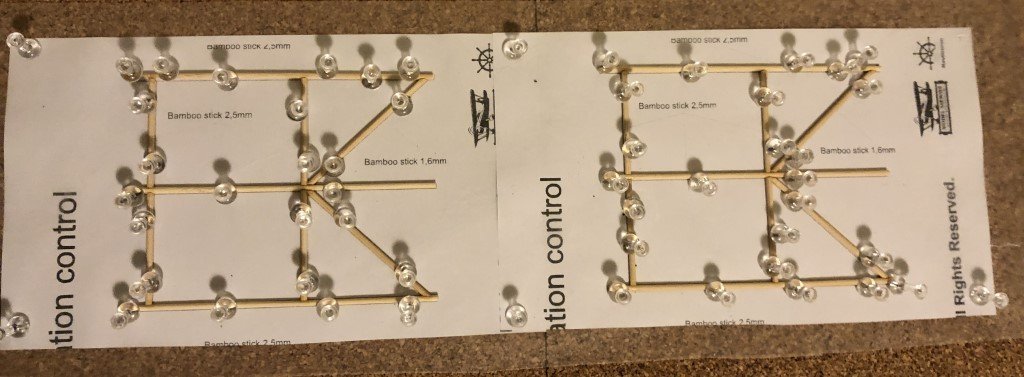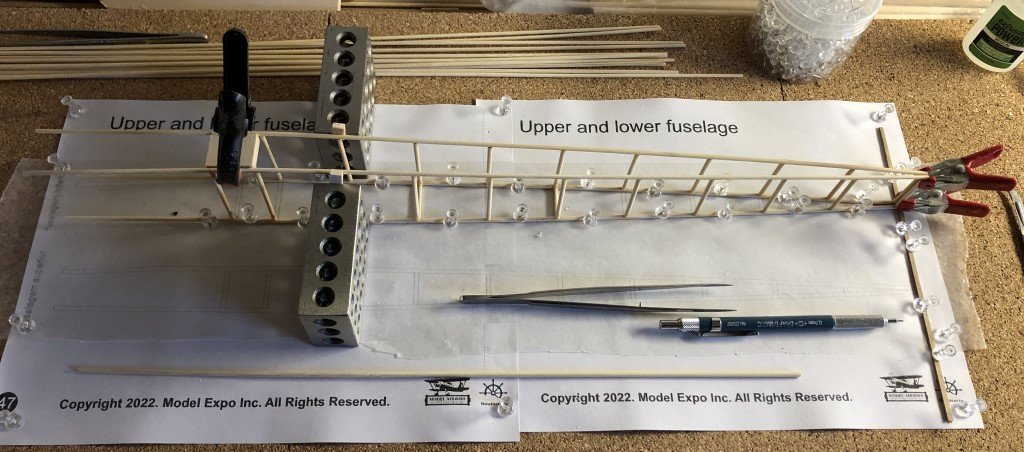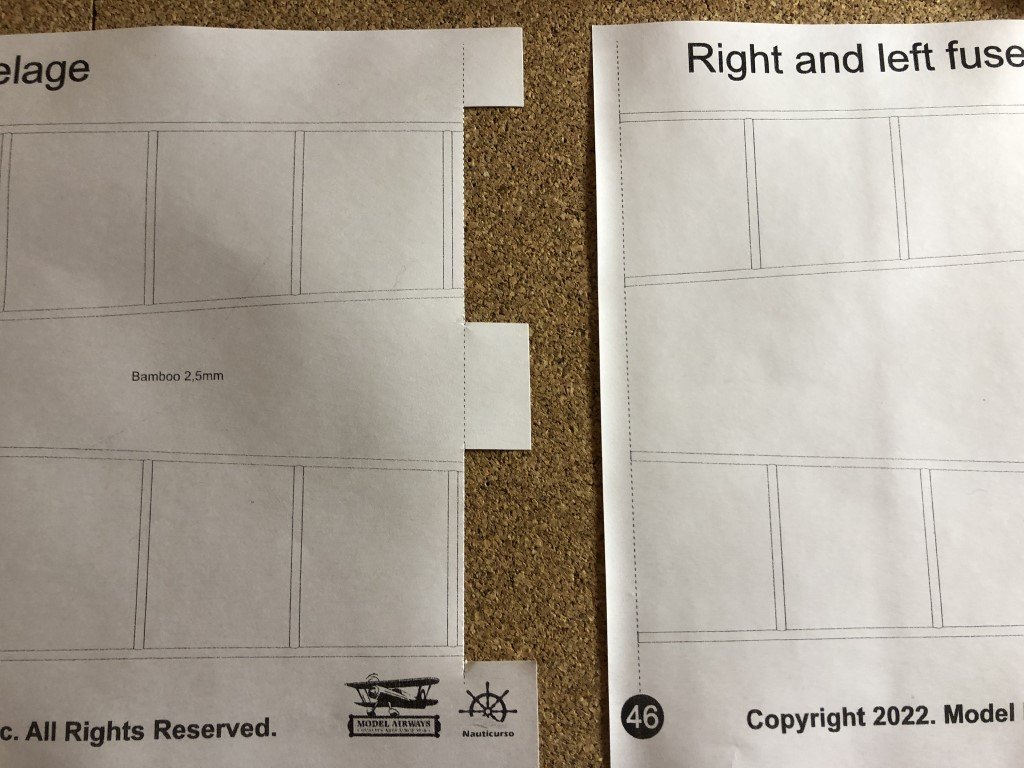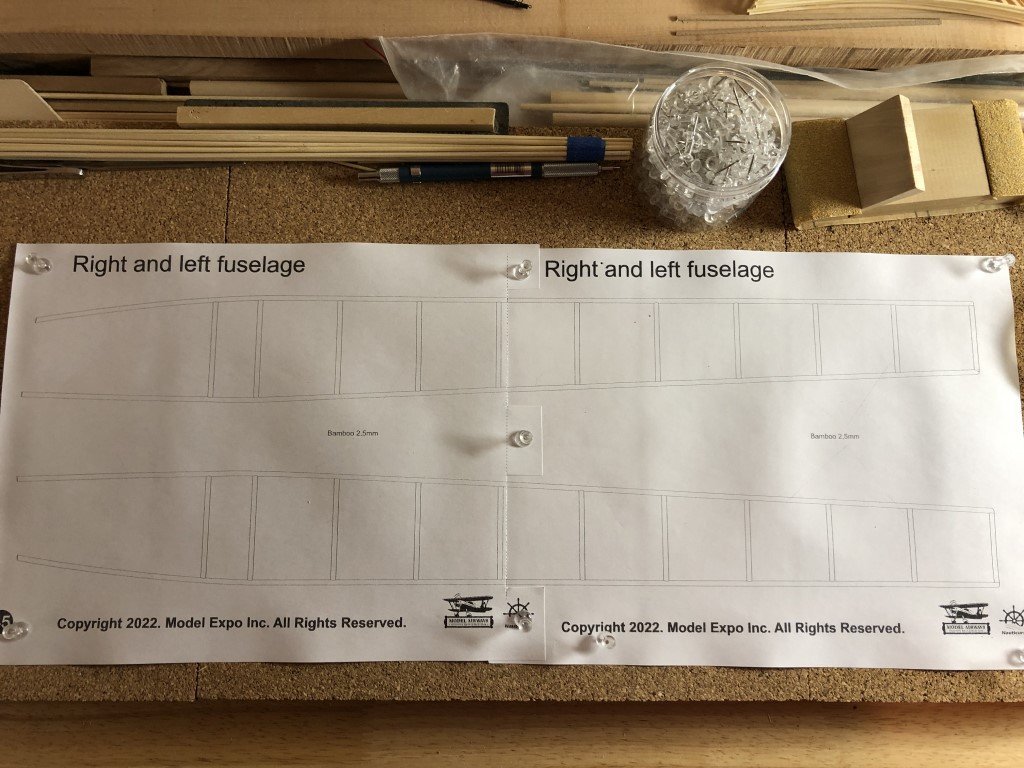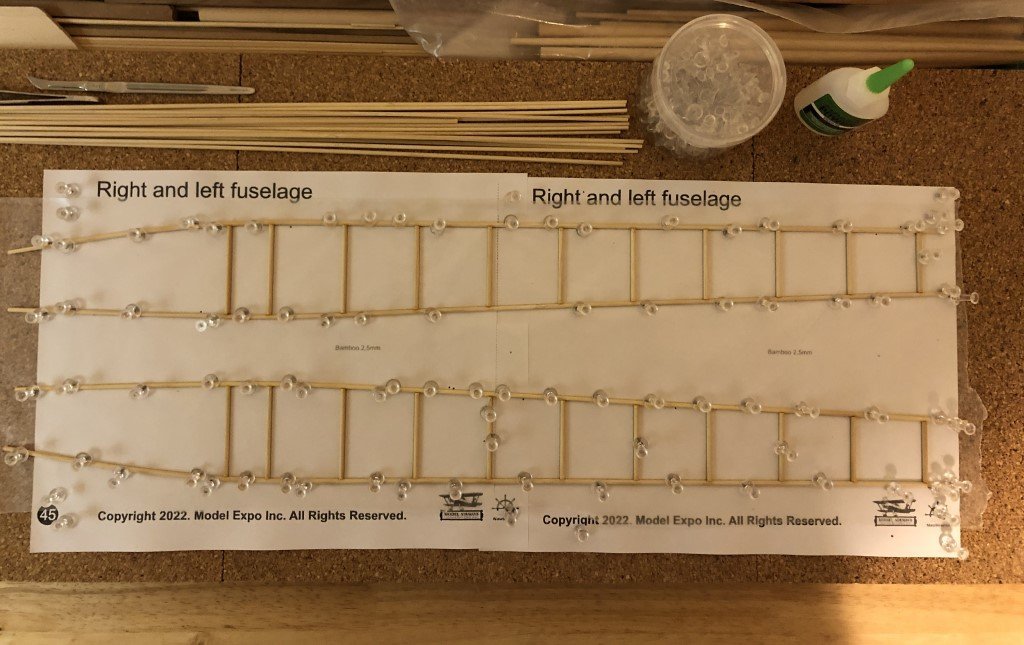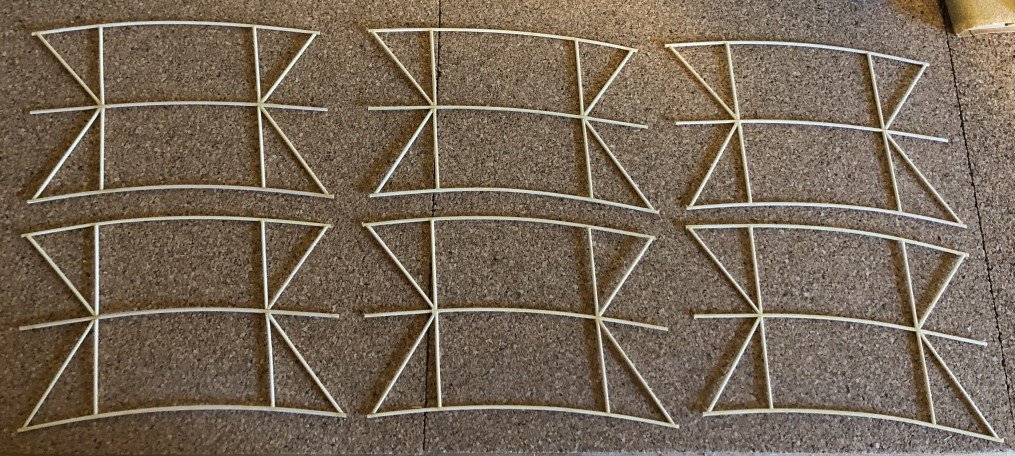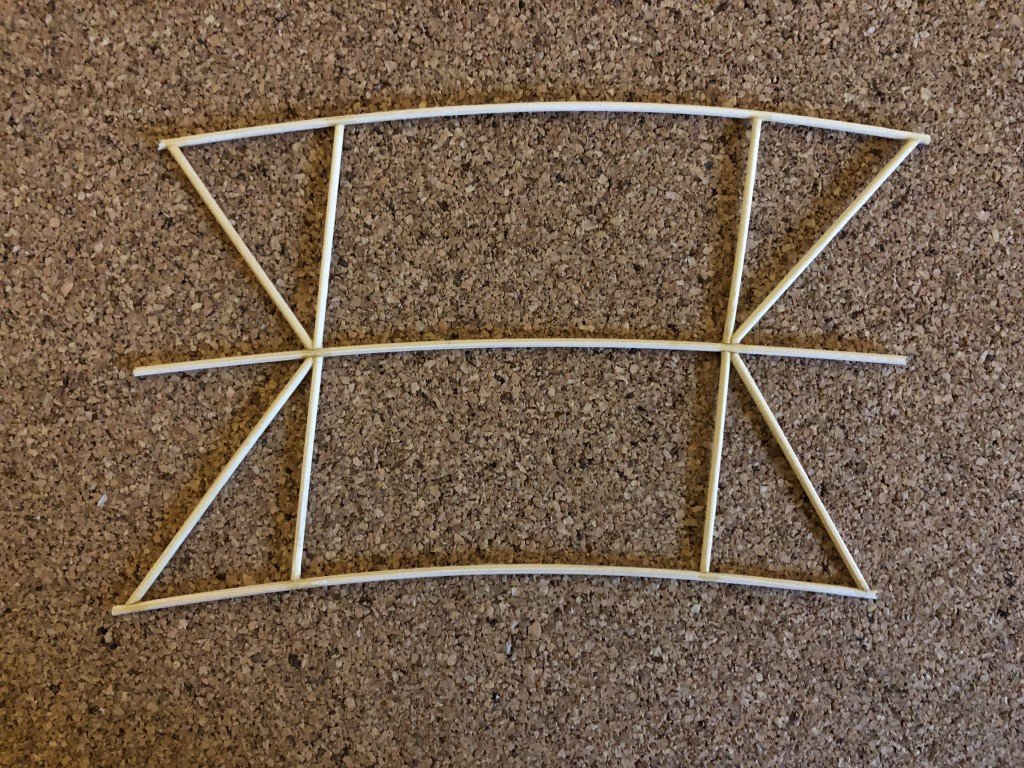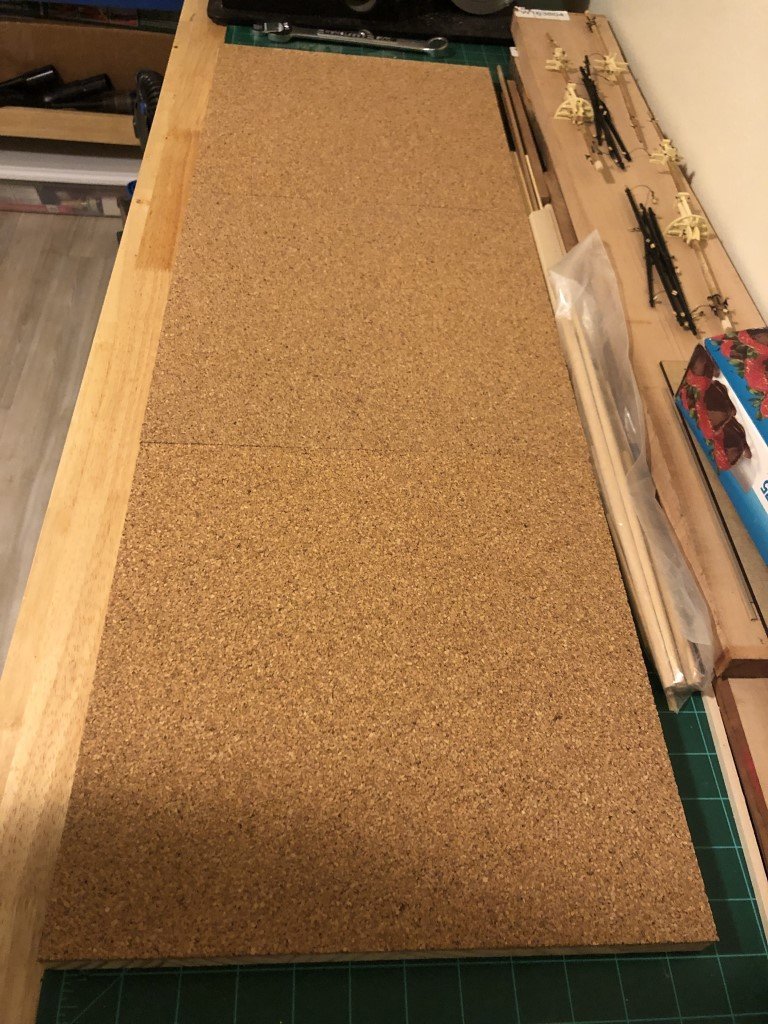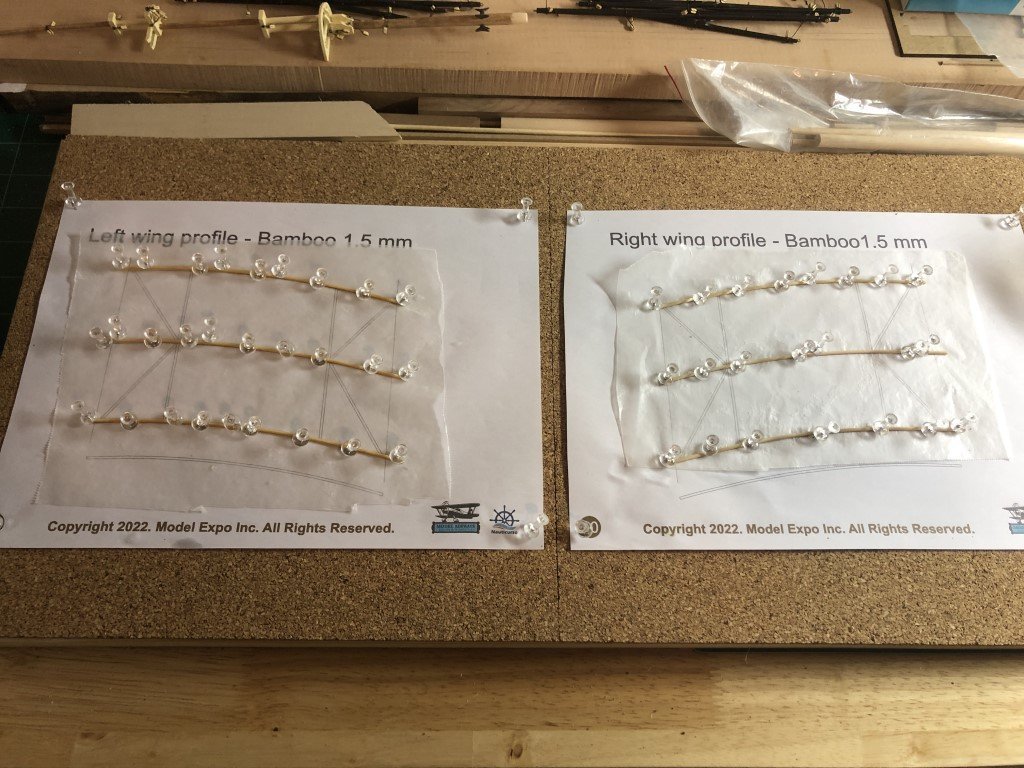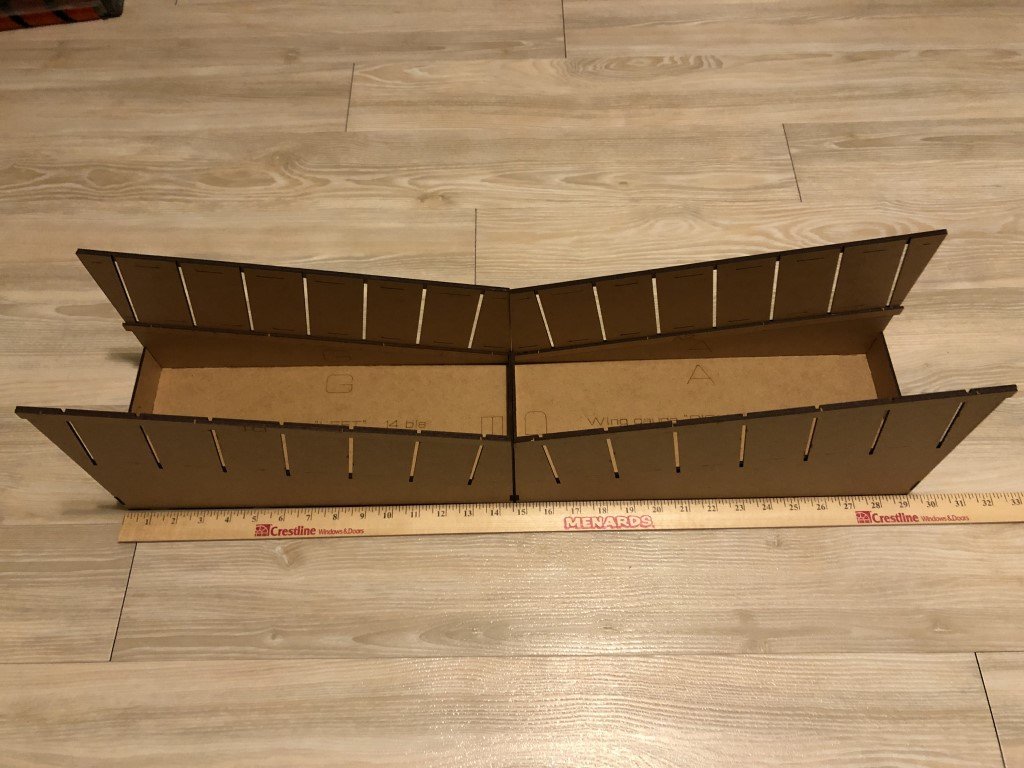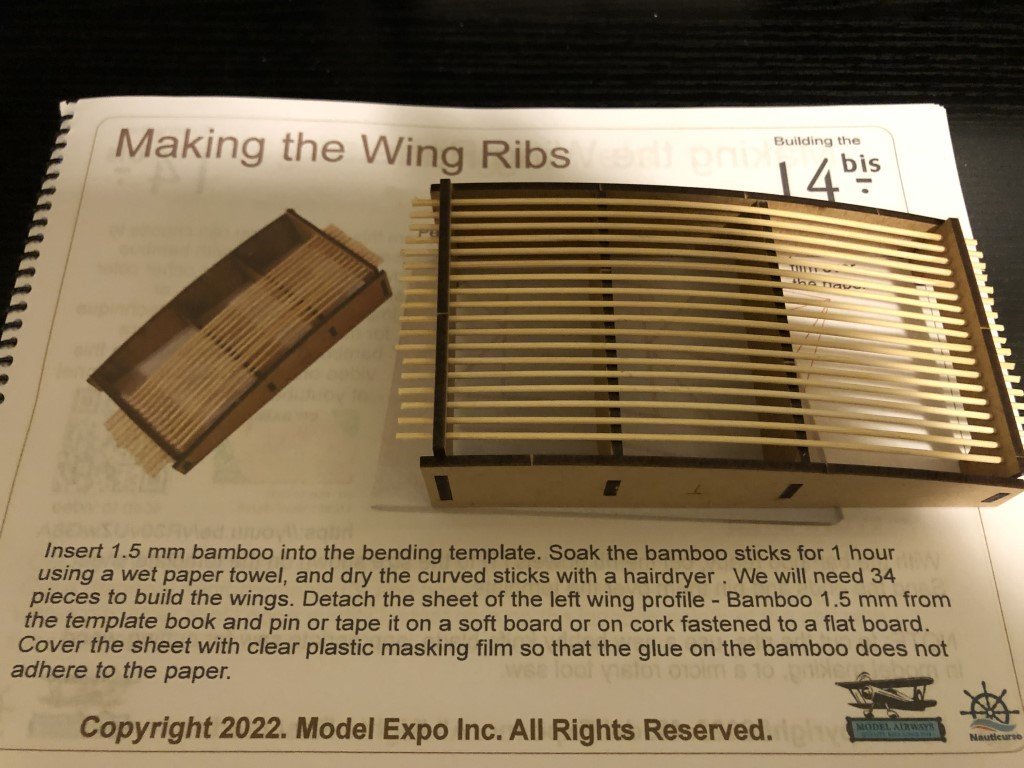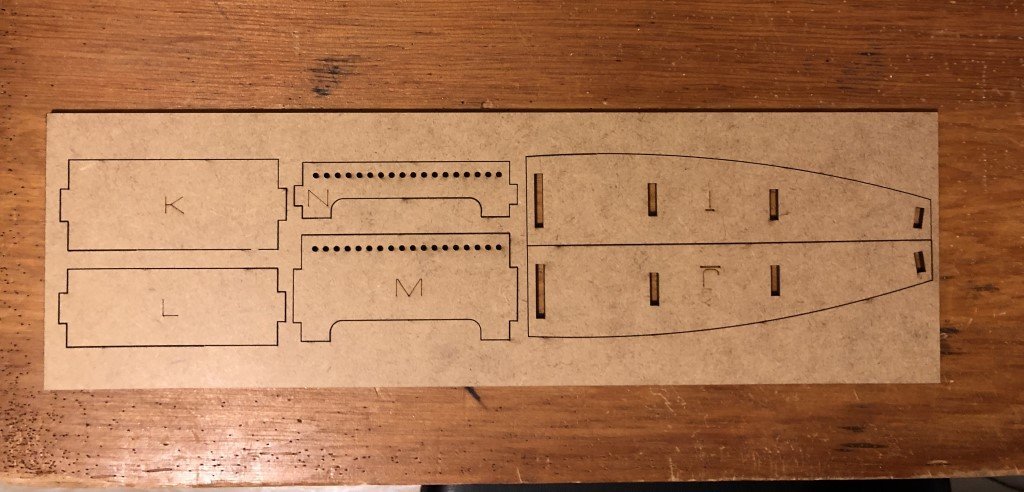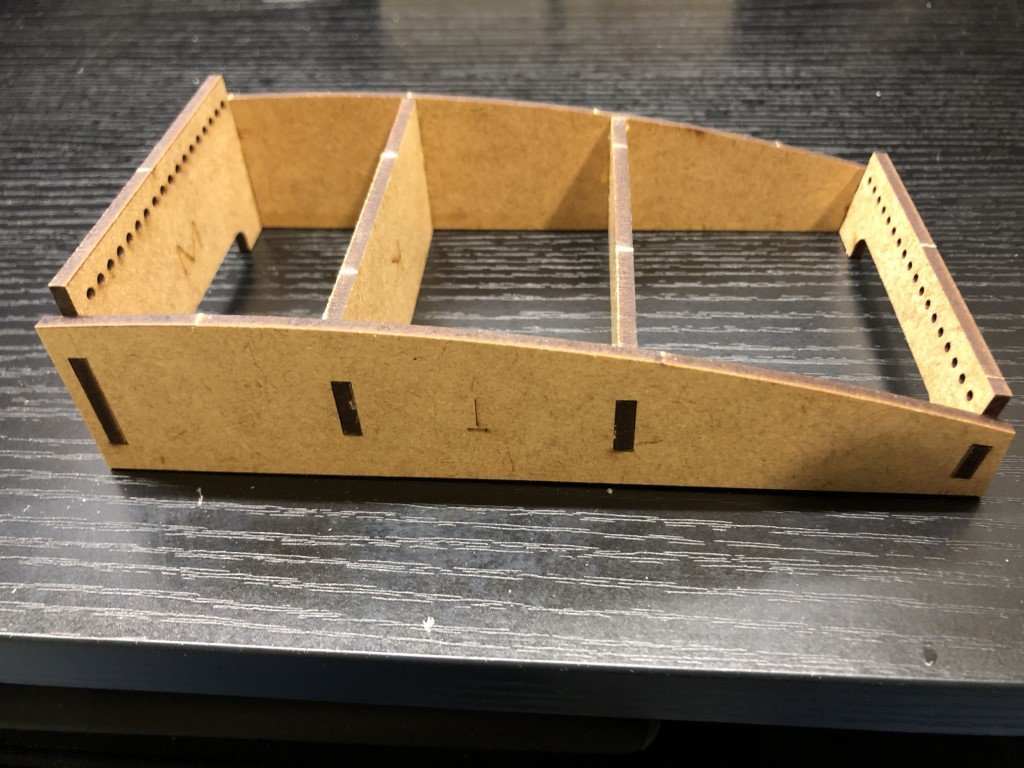-
Posts
803 -
Joined
-
Last visited
Content Type
Profiles
Forums
Gallery
Events
Everything posted by Greg Davis
-
To be truthful, there was never a time that leaving the nodes out was really on the table. I am using a light brown thread for the nodes; it is being tied around the dowels in a 'random' pattern that averages just under a scale foot and has a standard deviation of a couple of inches. Just a simple overhand fastning with a dab of CA. I haven't rigged a ship for a while and my knot making skills have slowed. But given how many will be needed for this plane, they are sure to get better fast. After snipping off the excess thread, the 'nodes' look like this: Once a brown wash is applied I'm hoping that the result will be a good representation of bamboo.
-
I had planned to build the nacelle structure this evening. This structure will complete the bulk of the fuselage; it will support the engine and landing gear, as well provide the junction points for the wings. The plan went into the dumpster whenI discovered that a number of laser cut parts were missing from the kit - 8 parts to be exact. I suspect that one sheet of laser cut parts was inadvertanly missed when the kit was packaged. So I've sent a replacement part request to Model Expo; I hope that they are swift with finding and shipping the missing pieces. In the meantime a new task will need to be chosen to keep moving on!
-
The remaining canard side has been added. There is an axle that passes through the canard and has a tube attached to it. The tube will eventually have a shaft passing thru it that attaches to the fuselage. Left / right motion for the canard will happen along this shaft. Up / down motion will happen along the axle in the canard. Four bamboo support beams will be added between the central axle bearings and the top / bottom of the canard - something to do tomorrow. The tubes that cross in the middle (where all the movement occurs) are soldered together. This may be the only soldered joint on the model. A jig is provided in the kit to properly align the tubes to be soldered. The jig worked great when I resistance soldered the joint.
-
Here the canard sides are being connected to the top (bottom?) of the structure. I've used 1-2-3 blocks to keep the sides perpendicular to the third side. I should be able to do the same for attaching the fourth side. To keep the top and bottom the same size, all the connecting pieces were ganged and then cut together on my table saw. I did this for the side pieces as well. The diagonal pieces were formed individually.
-
All of the crosspieces, top and bottom have been attached. In this photograph the two most forward top crosspieces are still pinned and drying. The instructions seem to imply that (top and bottom) you can pin the fuselage sides front-to-back right to the building board. In actuality, there is some curvature in the top / bottom profiles so this cannot be done. For both the top and bottom crosspiece installation, I was able to pin the sides flat starting at the front and going toward the rear to all but where the last two crosspieces would attach. After the 8 forward crosspieces dryed, the structure was unpinned and rotated until the region of the remaining crosspieces were flat on the building board. As with the wing panels, I am putting a bit of CA on both sides of each joint. I'm thinking about moving now to the basic canard construction. The canard is the last major bamboo dowel construction. Once that is done, I will be painting the wing panels, fuselage, and canard bamboo parts. After that, these subassemblies can be attacehed to non-bamboo parts and subassemblies. There is actually one more bamboo based subassembly - that of the ailerons. The initial flights of the 14bis were made without ailerons. They were added prior to the final flights the aircraft made and were controlled by wires connected to a shoulder harness that Dumont wore when piloting the machine. Right now I see them as being optional for the model.
-
The sides have been glued from both sides and now are being joined via the lower crosspieces. I glued and clamped the rear of the fuselage sides together first while respecting the angle of the junction. The two sides are pinned to the building board. I made a spacer to match the width the upper surface in the region where the pilot basket will be. The top is narrower than the bottom. The spacer together with a pair of 1 x 2 x 3 blocks and shims have let me set the sides centered and angled to the final shape of the fuselage. Hopefully this will give the desired symetrical trapazoidal shape at the end! I'm actually surprised that a jig was not provided for this stage of the fuselage construction. A couple of the crosspieces are already in - more later today. Not a great deal of space to work; using a long tweezer is helping me get the crosspieces into the correct locations.
-
I've moved on to the fuselage construction now. The plans for the fuselage sides are in the instruction booklet - not on a larger plan sheet. This is a place where Model Expo has gone a cheaper / less satisfactory way than in their other airplane and ship kits where they typically provide a number of full-size well documented plans. First thing to do is to connect the two needed plan segments into one. To deal with the alignment and overlap issues assocaited with working with two sheets, I cut sements out of one sheet so that it could be aligned more easily with the second sheet: After laying down some waxewd paper, the fuselage sides were easily assembled: The fuselage is constructed out of 2.5mm diameter bamboo. Unlike the 1.5mm diameter material used in the wing panels, here I noticed that the provided dowels often had reduced diameter near their ends. I suspect that the dowels are formed using drawplates and that the lead ends from the process were not always cut from the finished dowel before placing them in the kit. This is a quality control issue that Model Expo should look into! The actual side construction went quite smoothly. I will say that having a Byrnes table saw to cut all the uprights made the job quick. Right now the fuselage construction brings me back to one of my favorite rubber band freeflight models. It's now called Fly Boy and made by the Guillow's company; back in the day it was the Cloud Buster made by Comet and I must have made half a dozen of them. I will leave the sides pinned down overnight. Tomorrow they will be flipped over so that I can put another drop of CA on the joints. Once that is dry I will likely start connecting the sides. The final profile will be trapazoidal in cross-section with the top narrower than the bottom.
-
All six of the wing panels have been glued up now. I am worried about how strong these will be because of all the butt joints - are the panels going to collapse when they are incorporated into the wings? When I made balsa planes as a youngster I never worried about this and really never had too many failures; however all the planes were covered with tissue paper / silkspan or other types of coverings. So I have been trying to think of a reinforcement scheme that would be approprite for the model. I did find a couple of references that claimed that there were 'aluminum fixtures' used in construction of the actual plane. What these looked like I do not know. It also is reported that the original plans (and plane, except for the basket) no longer exist. All current plans are reconstructions based heavily on photographs often using the basket as a means to scale dimensions of the plane. Here is a link to a (what I think is a very informative) paper about the 14 bis https://www.fzt.haw-hamburg.de/pers/Scholz/ewade/2007/CEAS2007/papers2007/ceas-2007-065.pdf . Here is a pic of the six matching wing panels: I'm going to set these aside for a while until I finalize plans for replication of bamboo nodes (or not including them) and possible reinforment of the butt joints. Pinning the joints is out of the question. I am wondering if drilling small holes thru the dowels on both sides of the joints and then tying the pieces together would be a way to go. I don't know how isuccesful I would be in doing this and how intrusive the result would look.
-
That explains a lot! I'm going to need to rely on glued joints and the rigging lines to keep everything in place. It shouldn't be a problem since these dowels are between 1.5mm and 2mm in diameter and bend very easily. On the other hand, it is interesting that Model Expo / Model Airways is advertising the fact that the kit is made of bamboo and Freijo wood because the original plane was built from these materials. I am so used to the arguments in model ship construction to rarely (or never) use the same wood the original ship was made from because of one would like the grain of the wood to shrink with the scale of the model. I wonder if there would be a another material to build a 1:16 model of the 14bis with that would respect scaling of grain and have better ability to hold bend shapes. Now I need to put these ideas out of my mind before I go down a rabbit hole, researching everything I can about the plane and start over with a completely scratch-built model ... Keep to the kit, keep to the kit ...
-
Mark - I tried that initially - as directed in the instructions, I soaked the ribs (in the jig) with water from wet paper towels for an hour and then used a hair dryer on high to dry them out. I then left them in the jig overnight expecting the ribs to hold their shape. They had some curve, but not as much as desired. That's when I went to soaking the ribs in water, pinning them to the plans and letting the wood dry on its own. But there was essentually no improvement in holding the shape. Bamboo is new to me in this type of application and it surely doesn't behave like wood I've used / bent for making model ships! It might be the case that if the jig had been designed with a more extreme curvature, then after springing back the ribs would be close to the needed shape. I imagine that a good deal of experimention would be needed to get this type of a jig right. I'm just hoping that the bamboo is flexible enough so that the shape is held by the way the components fit together together with the rigging that comes later. At this point I think that will be the case, but time will tell. Greg
-
This afternoon I checked to see if the resoaked strips were holding the desired shape - not any better than when they came out of the rib jig. The amount of curvature doesn't seem to be something the bamboo dowel wants to hold. I decided not to be too concerned because the material is so flexible and went ahead to insert the spacers and diagonals. I fitted the eight pieces and put a bit of CA on each joint region, let it dry, turned the structure over and put another drop of CA on the reverse side of each joint. The end of each rib was trimmed to finish this stage of the assembly process. Here is the resulting first wing panel: For reference, the panel just fits inside a trapazoid with height 3.75" and length 6.26". The diagonals and vertical spacers are holding the desired rib camber for the top and bottom ribs, as well as for the mid-portion of the middle rib. the ends of the middle rib spring up just a bit now; however, later in the build there will be vertical rigging that attaches to the ends of the ribs. By rigging from bottom to top the middle rib ends should be able to be pulled down into their correct position. Five more panels to assemble!
-
I bought a 1 ft x 3 ft sheet of pine - it is the kind made up of strips glued together. I find that these stay pretty flat and don't cup or warp much. I then attached 1 ft squares of cork to the wood using heavy duty double sided tape. This will become the basic building board for the wing panels / fuselage sides, etc. Here is the start of a pair of wing panels, the soaked (for the second time!) ribs are held in place with push pins: I'll let the ribs dry overnight once again and start glueing up the remaining components tomorrow.
-
I left the ribs in the jig for nearly 24 hours; took a couple out and as expected, they are not keeping their shape very well. Six are soaking in warm water now and then I will pin them to the building board in the right shape. I will let them dry a bit before adding the rest of the wing panel parts. Did a little research on bamboo last night, trying to find out more on the distance between nodes. It seems that there is a good deal of variability based on the diameter of the bamboo and the species (of which there are apparentaly hundreds). I alo measured the distances between nodes on a piece of 3/4" diameter bamboo that I have. These distances averaged a bit more than 10 inches. The material in the kit is 1.5mm. If this is correctly scaled, the actual plane would have used 2.4 cm; i.e., about 1 in diameter bamboo. I would think that it would be fair to guess that the nodes on this diameter bamboo would be roughly 1 foot. Since the model has ribs with length 6 1/8 in, this would implie actual length just over 8 ft. In turn, I would think maybe 6 nodes, since you would likely minimize the number of nodes / not have one too close to the end of a rib. Interestingly, the count of nodes on the ribs shown in the instruction booklet is in the 20 - 22 range - this number of nodes would be equivalent to a node spacing of around 4.5". I think this may be too small of a distance and that 6 or 7 nodes would be more realistic. So I will likely go with that number. Here is how I think I will proceed on each panel: resoak / shape ribs after they have been in jig glue in the vertical spaces and diagonal reinforcements (before painting / adding nodes) trim ribs to appropriate length add nodes individually (not using blanket stitch as in video) paint with yellow ochre acylic It might take a little longer, but the result may be a bit better. I don't like their idea of painting and then gluing.
-
Thank you for the added info! Dumont's plane, in some ways, reminds me of some of the early MPA (man powered aircraft) designs. My dad had been a B-17 pilot in WWII and afterwards became interested in experimental aircraft and very much interested in MPA's. By occupation he was a design engineer and this helped him design a (potentially) functional MPA. I remember all the work he did on it when I was young - for example, the ribs were made out of 1/8" square pine stringers; the wingspan was to be about 40 feet - but the project was never completed. I guess it eventually took too long and he lost interest. When I was a teen and building a lot of free flight and control line planes, I did try to work on his plane as well, but it really didn't help that much. It should have though as I ended up a reasonable bicycle racer that could easily wrench my bikes as well as a mathematics professor.
-
Ribs have been soaked via the suggested papertowel method. I also blew hot air on the wetted ribs for a while. Still not overly confident that the hairdryer will have done its thing, so I am going to leave the ribs in the jig overnight before attempting the wing panel construction. Before starting the wing panels a very important decision needs to be made - use the smooth bamboo dowels as provided, or try to simulate the periodic nodes that make bamboo truely recognizable. As mentioned before there is a video on the @Nauticurso YouTube channel: https://youtu.be/vR30vUZwG8A . The suggestion is to paint the trips with yellow ocher (can do that!). Then to simulate the nodes thin rigging line is wraped around the dowel using a blanket stitch. Finally they cover the whole dowel / rigging line structure with CA to fix the line in place. The whole process looks pretty messy (and full of CA vapor); but also seems to leave a thread between each of the circular nodes. I would like to have the nodes represented, but I don't want the line between them. I'm trying to think of a way that these lines are removed from the finished work - perhaps they can be cut and carved off the dowel after being afixed. I guess the best thing to do is an experiment or two!
-
I also have assembled the wing building jigs. They are substantial structures. When set side to side you can get a good idea of both the model's wingspan (29.5 in) and the massive amount of dihedral. With this amount of dihedral the plane must have been very stable, and most likely was a factor in way it was difficult to turn. Quite different from the more maneuverable Wright Flyer design with a flat center wing section, and the wing tips acuatully dipping down at the ends.
-
I just loaded up the rib shaping jig. Within the bunch of provided 1.5mm diameter bamboo strips there were plenty that slid into the jig. The bamboo being very flexible takes the needed curve of camber well. The holes in the jig must not leave much extra space as I did try a couple of strips that did not pass thru the holes - they can be used for other parts of the construction. I think it is important to note that the finished ribs are a little longer than the jig itself, so it is important that the strips extend far enough past each of the end of the jig to allow for trimming later. Now it is time to soak the ribs and to see if the wood will take the curve permanently (or at least long enough to get them glued up in the wing panels). I'm not sure about drying the ribs with a hairdryer vs leaving them in the jig long enough to dry on their own. Some decision will need to be made in about an hour!
-
I've assembled the jig for bending the ribs. It is made out of siz pieces that are laser cut from a sheet of MDF. All of the pieces released from the sheet with ease. The completed jig looks like this: Bamboo strips will be threaded thru the holes on the two ends allowing them to be bent to the proper camber. The instructions say to place wet paper towels over the strips for about an hour. Then the builder is directed to dry the pieces with a hairdryer. The ribs can then be removed and will hopefully maintain the desired camber. Apparently 34 of these need to be made, so the jig needs to be fully loaded twice. I hope to load the jig up tomorrow to make the first batch. Also, to give you an indication of the size of the model, the cord of the wing is just over 6 inches - the original plane would have had wings approximately 8 feet wide.
About us
Modelshipworld - Advancing Ship Modeling through Research
SSL Secured
Your security is important for us so this Website is SSL-Secured
NRG Mailing Address
Nautical Research Guild
237 South Lincoln Street
Westmont IL, 60559-1917
Model Ship World ® and the MSW logo are Registered Trademarks, and belong to the Nautical Research Guild (United States Patent and Trademark Office: No. 6,929,264 & No. 6,929,274, registered Dec. 20, 2022)
Helpful Links
About the NRG
If you enjoy building ship models that are historically accurate as well as beautiful, then The Nautical Research Guild (NRG) is just right for you.
The Guild is a non-profit educational organization whose mission is to “Advance Ship Modeling Through Research”. We provide support to our members in their efforts to raise the quality of their model ships.
The Nautical Research Guild has published our world-renowned quarterly magazine, The Nautical Research Journal, since 1955. The pages of the Journal are full of articles by accomplished ship modelers who show you how they create those exquisite details on their models, and by maritime historians who show you the correct details to build. The Journal is available in both print and digital editions. Go to the NRG web site (www.thenrg.org) to download a complimentary digital copy of the Journal. The NRG also publishes plan sets, books and compilations of back issues of the Journal and the former Ships in Scale and Model Ship Builder magazines.


